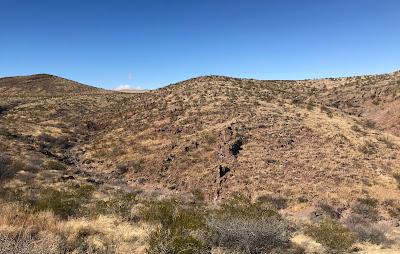 |
| Christmas cholla |
 |
| Mount Riley and Cox Peak to the south |
 |
| Aden Crater in the distance |
 |
| Yucca near Aden Crater |
The next day promised more of the same, but I went out anyway, slightly earlier, this time headed for the West Potrillo Wilderness. I had checked the weather map and realized (a bit late for our Good Sight hike) that the areas north of I- 10 and further west of town were getting stiffer winds and colder temperatures. I was hoping for better conditions south of the highway and substantially east of where we had been. It didn't appear that promising after about 40 minutes of driving and nearing Aden Crater, when I looked out the window to see the creosote being batted around by the wind. I continued on anyway, rounding the volcano and then heading southwest after opening and shutting a gate near a corral area. The road, after reaching the dry Brock Tank is bordered on both sides by wilderness and I was glad to see there were several signs indicating such.
It's the longest "cherry-stem" penetrating the West Potrillo Wilderness, and I wasn't really sure why it was needed until I got to the end. Here, was an old line cabin along with windmill, solar panel, and water storage tanks (all now defunct).
I started off to the west, initially following the arroyo channel, but then just headed on a line towards the box section after catching a glimpse of it in the distance. After cresting and descending a small rise, I was close enough to begin walking in the gray gravel and boulders of the arroyo. Soon after where I entered, the stream channel cuts through the a cinder cone. There were leafless hackberry trees lining the sides of the now much narrower dry creek bed and the cliffs above alternated between blocky gray basalt and rusty red consolidated cinders where electric yellow lichen always seems to grow. This particular canyon didn't seem to have enough flow to have carved out any significant tinajas or even to have smoothed down the basalt to any great degree, unlike one I visited just a few miles to the southwest a few years ago. There wasn't much scrambling to be done either. I spied alcoves above, but opted not to climb up on the slippery cinders. I did look into one that was eye-level, without much to report.
The depth of the little box is between 25 and 70 feet and extends for about a mile or so before shallowing up after rounding a second cinder cone. Shortly after that is the head of the arroyo. I got up out of the canyon and could see a couple of low cinder cones about a mile and a half off to the west.
The wind up on top was surprisingly mild, so I headed south across the mesa to look at the next arroyo over. It wasn't much and I wished I had headed north instead. It was just warm enough for the wind not to be problem and I walked along through the pale dry grass, which appeared to have had some good growth this past summer.
Cholla and barrel cactus were there and here. Flocks of sparrow-sized and slightly larger birds flew from bush to bush at my approach throughout much of my walk. I even took a few breaks and got out my binoculars to get a closer look at some of them (a rarity). I had never seen this many birds in this part of the Monument before in any season. Unfortunately I'm not much for identification on the fly. I just don't practice enough. There were definitely some black throated sparrows, some species of the flycatcher and of course I flushed out some quail several times (probably scaled, definitely not Gambel's).
It was a very mellow return trip. In the canyon the wind was barely a factor, but now at times the wind even stopped altogether as I kept walking through areas of just dried grass and gravel with only the occasional lone mesquite or yucca rising up with room to grow.
This harsh desert seemed quite benign at least for a few winter hours from late morning to early afternoon. Back where I parked I investigated the old cabin and environs. Inside the stucco and chicken wire dwelling, there was charcoal written graffiti on the walls, and animal tracks in the accumulated dust. Forgotten places like this always give me pause. I imagined moments in the past: the day the cabin was built, then some cold night when cowboys took shelter inside, and then the last day it provided any useful function to anyone ( if you are someone out there who knows anything about this cabin, please let me hear your story in the comment box).




















No comments:
Post a Comment